
Source: AFP.
The concentration question
In Reconstructing global equities: Strategic allocation in a new world, we argued that market-cap benchmarks are not neutral structures. They embed specific exposures – to the US, to growth as a style, to technology as a sector, and to the USD as a currency – that reflect the momentum of the past cycle rather than the shape of the next one. A regionally structured allocation, by contrast, offers investors a way to align equity exposure with the dispersion of global growth, valuation, and policy regimes already underway.
This companion piece examines the most dominant of those exposures: US equities. With a weight touching an all-time high of 65% in global indices earlier in the year (see Exhibit 1), US equities anchor most discretionary portfolios. That weight reflects not only past outperformance, but a set of forward assumptions – around resilience, innovation, capital flows and policy credibility – that may be harder to justify in today’s global regime.
Valuations alone make the case for scrutiny: US equities trade at a meaningfully higher price-to-earnings ratios compared to their peers in Europe, Japan or Asia ex-Japan, even adjusting for sector composition (see Exhibit 2). Relative to global averages, the US market continues to command a so-called “valuation premium” across multiple segments. This premium has often been interpreted as a reflection of structural advantages: stronger institutions, a more innovative corporate sector, and a history of more reliable earnings delivery.
However, such advantages must eventually express themselves in returns. Valuations, in other words, are not neutral: they are forward-looking forecasts. A higher price-to-earnings (P/E) ratio implies stronger expected earnings growth, or a lower perceived risk premium, or both. For example, if US equities trade at a 50% premium to peers, this difference must be justified by superior future cash flows or a lower discount rate. If those assumptions fail to materialise, the risk of valuation compression, resulting in underperformance, rises.
Exhibit 1: Share of US in MSCI ACWI
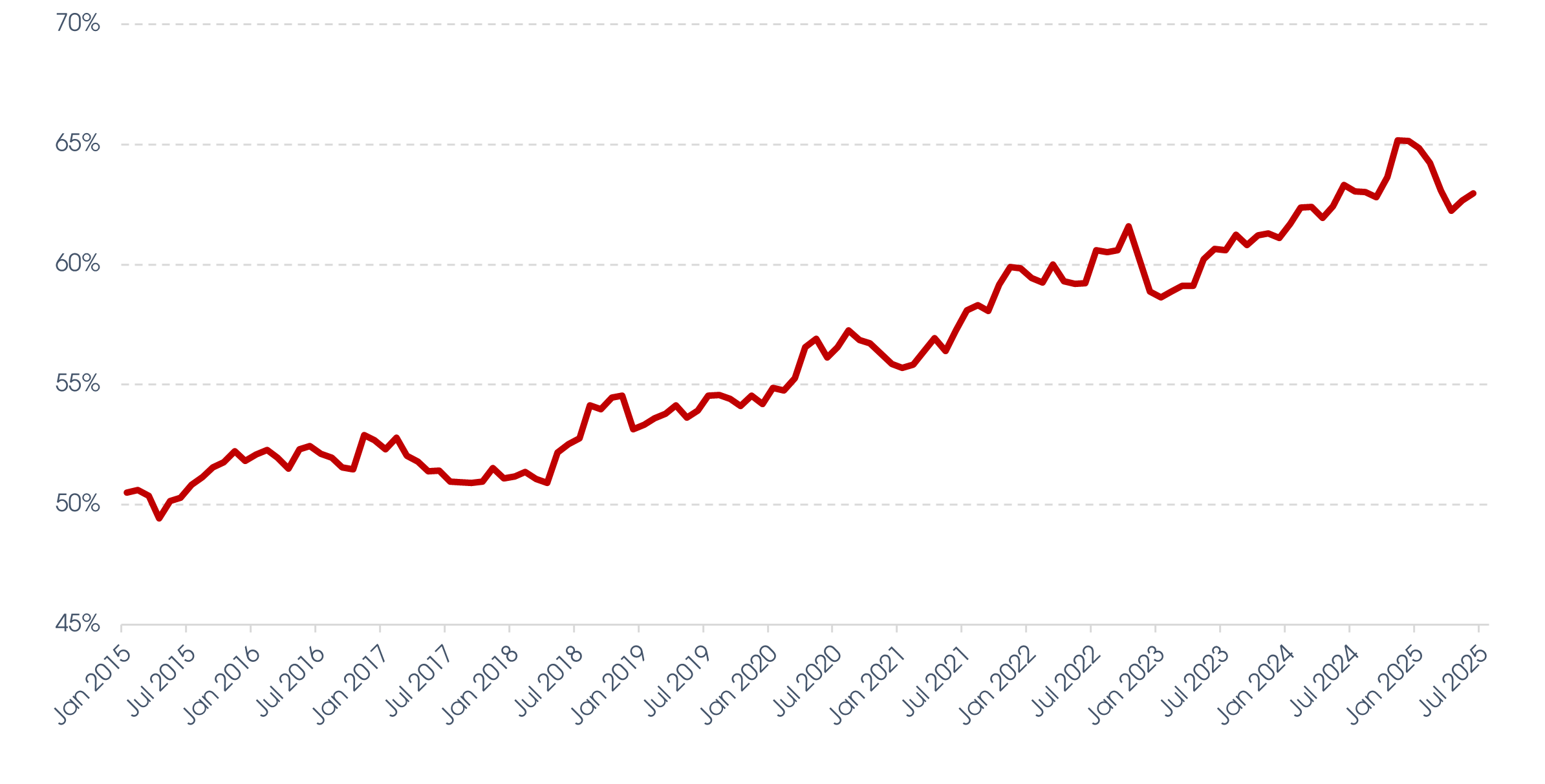
Source: Bloomberg, MSCI, Bank of Singapore, data as of 29 Jul 2025.
The following sections assess the basis for assumptions underlying the US valuation premium. First, we examine whether the underlying drivers of this premia are robust. Second, we decompose the sources of US equity outperformance over the past 10 to 15 years as well as over longer horizons to evaluate whether those drivers are repeatable or largely regime-dependent. And finally, we consider the conditions required to sustain US leadership at current valuations – and whether those conditions remain in place.
Exhibit 2: 12-month forward P/E ratios
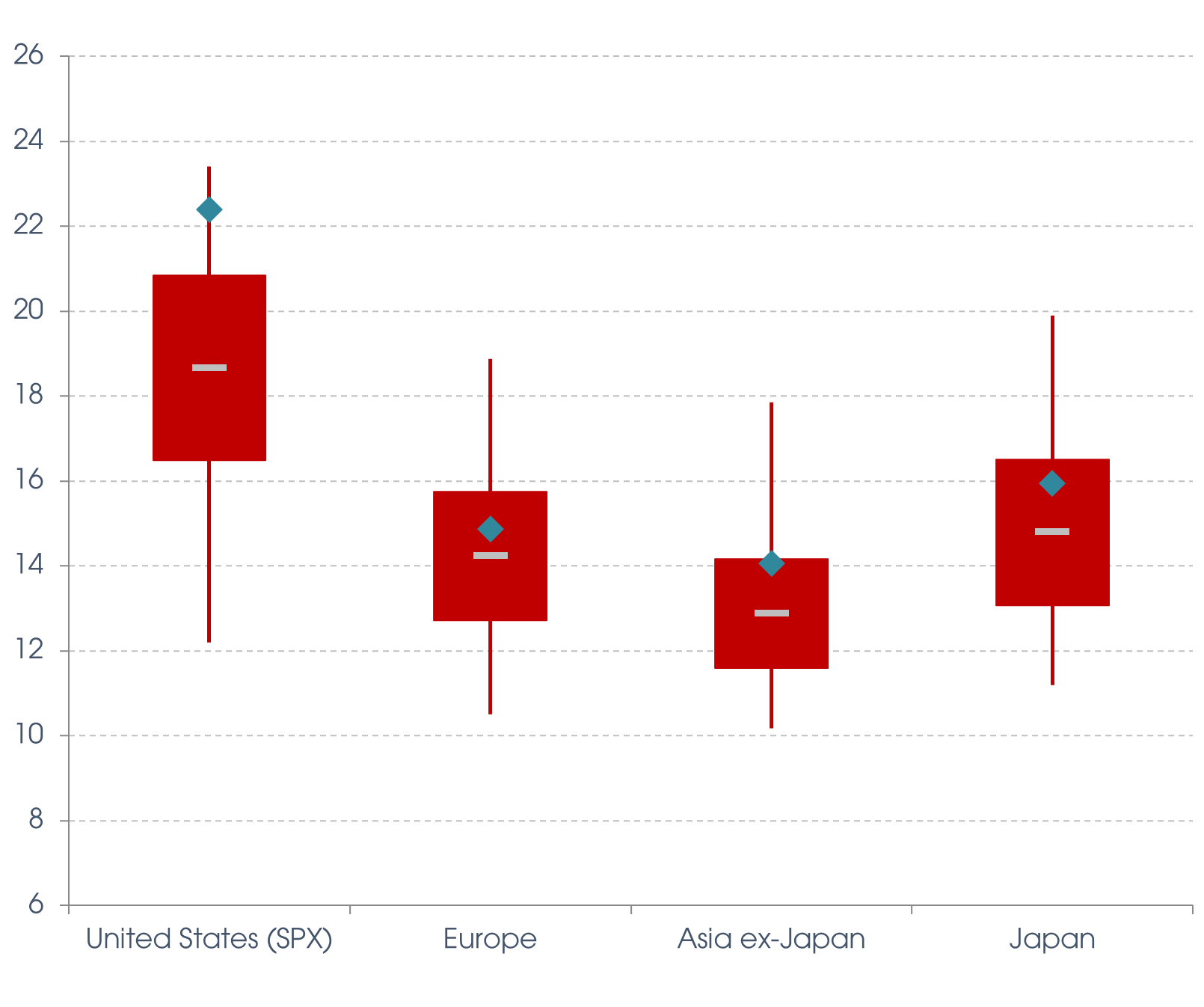
Note: Chart shows the forward P/E ratios of major equity indices based on current prices and blended forward 12-month consensus earnings estimates, vs their respective 10-year historical highs and lows, as well as levels corresponding to one standard deviation above and below their 10-year historical averages.
Source: Bloomberg, MSCI, Bank of Singapore, data as of 29 Jul 2025.
The conclusion is not that US equities should be avoided. It is that their continued dominance in global portfolios relies on a combination of factors – elevated margins, persistent valuation premia, favourable policy conditions, and ongoing global preference for US risk assets – that appear increasingly difficult to sustain. A more balanced equity allocation, regionally and structurally, may now be better aligned with long-term investment goals.
Questioning assumed advantages
Valuation premia are rarely durable without clear economic foundations. If US equities are to justify structurally higher valuations, the underlying advantages must be both significant and persistent. This section examines the common assumptions behind US equity leadership, and considers whether they continue to warrant the premium currently embedded in market prices.
The US is, by many measures, one of the most structurally advantaged equity markets in the world. It combines deep equity capital markets which attract foreign investments (see Exhibit 3).
It combines strong legal protections for investors, and a regulatory environment that supports corporate growth (see Exhibit 4).
Exhibit 3: Gross portfolio equity and investment fund shares liabilities/GDP (2020, in %; top 20 high income countries)
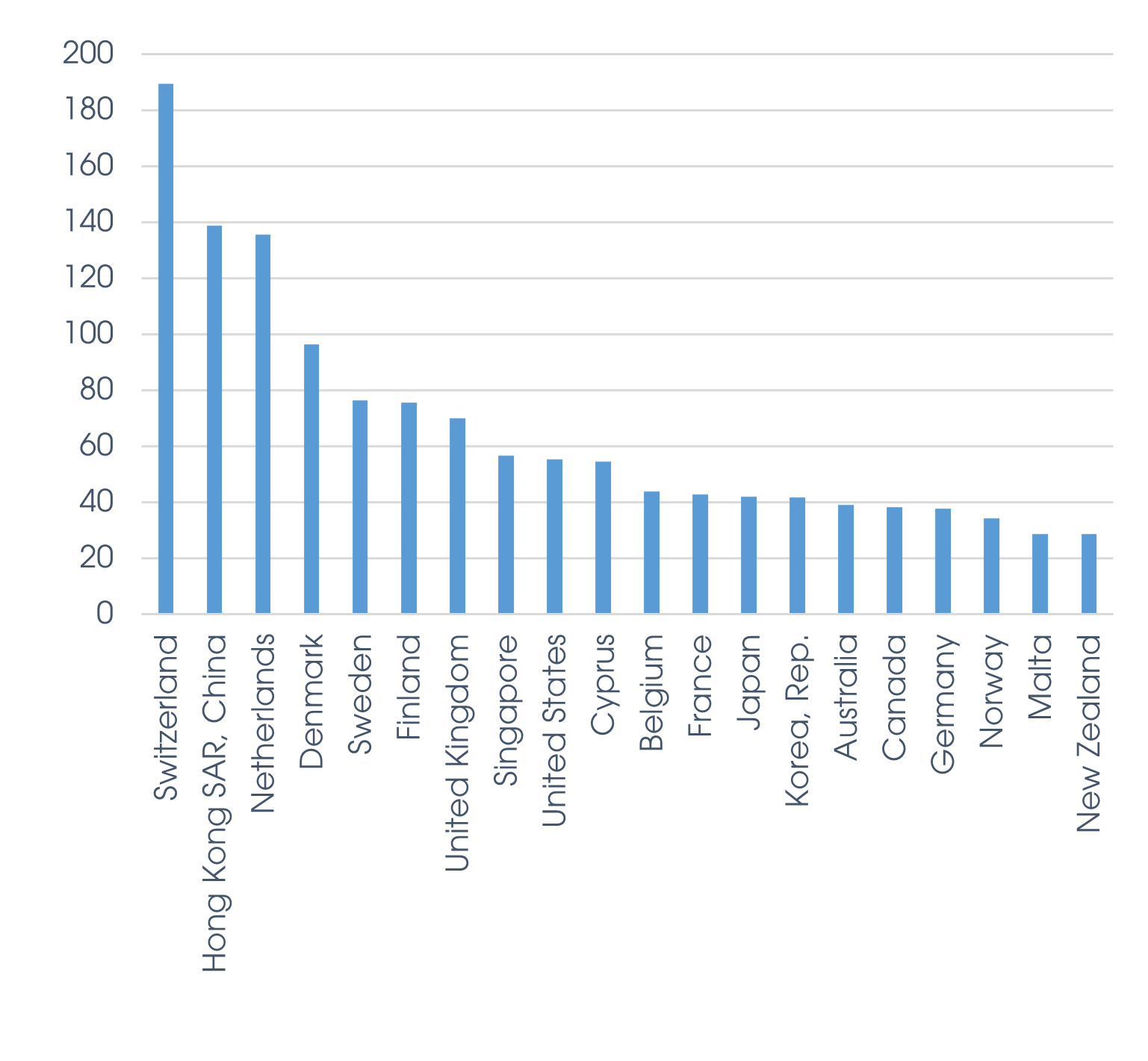
Note: Ratio of gross portfolio equity and investment fund shares liabilities to GDP. Equity liabilities include shares, stocks, participation, and similar documents (such as American depository receipts) that usually denote ownership of equity. Interpretation is that High equity liabilities = attractive destination for foreign equity capital.
Source: World Bank Global Financial Development database.
Exhibit 4: Top 5 countries based on key governance indicators and US rank
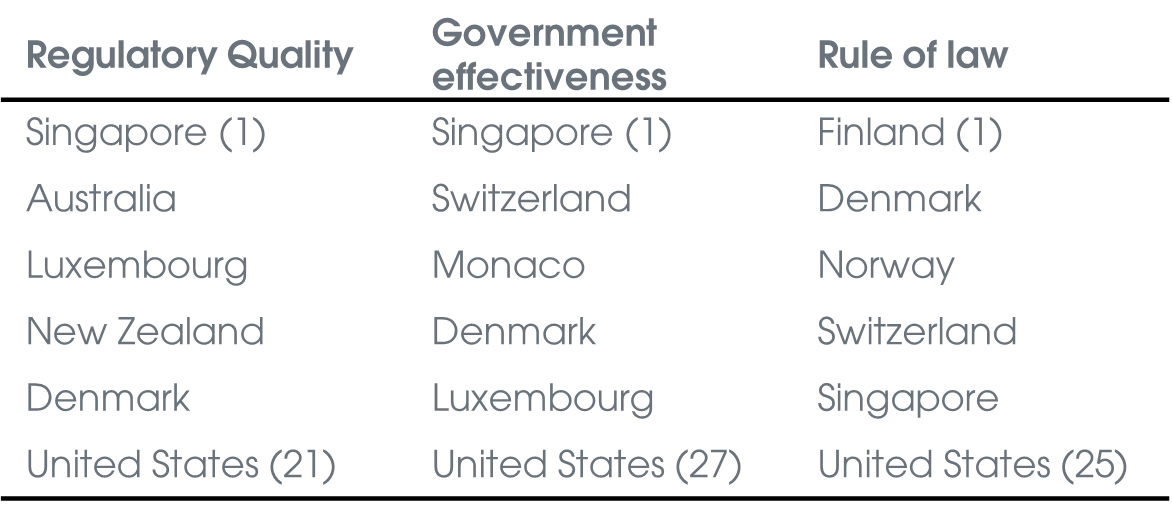
Source: World Bank Worldwide Governance Indicators. Sample = 213 countries
US companies operate in a large, competitive domestic market, with access to global demand and vast financial resources beyond equity capital markets (see Exhibit 5).
Exhibit 5: Domestic credit to private sector GDP (2020, in %; top 20 high income countries)
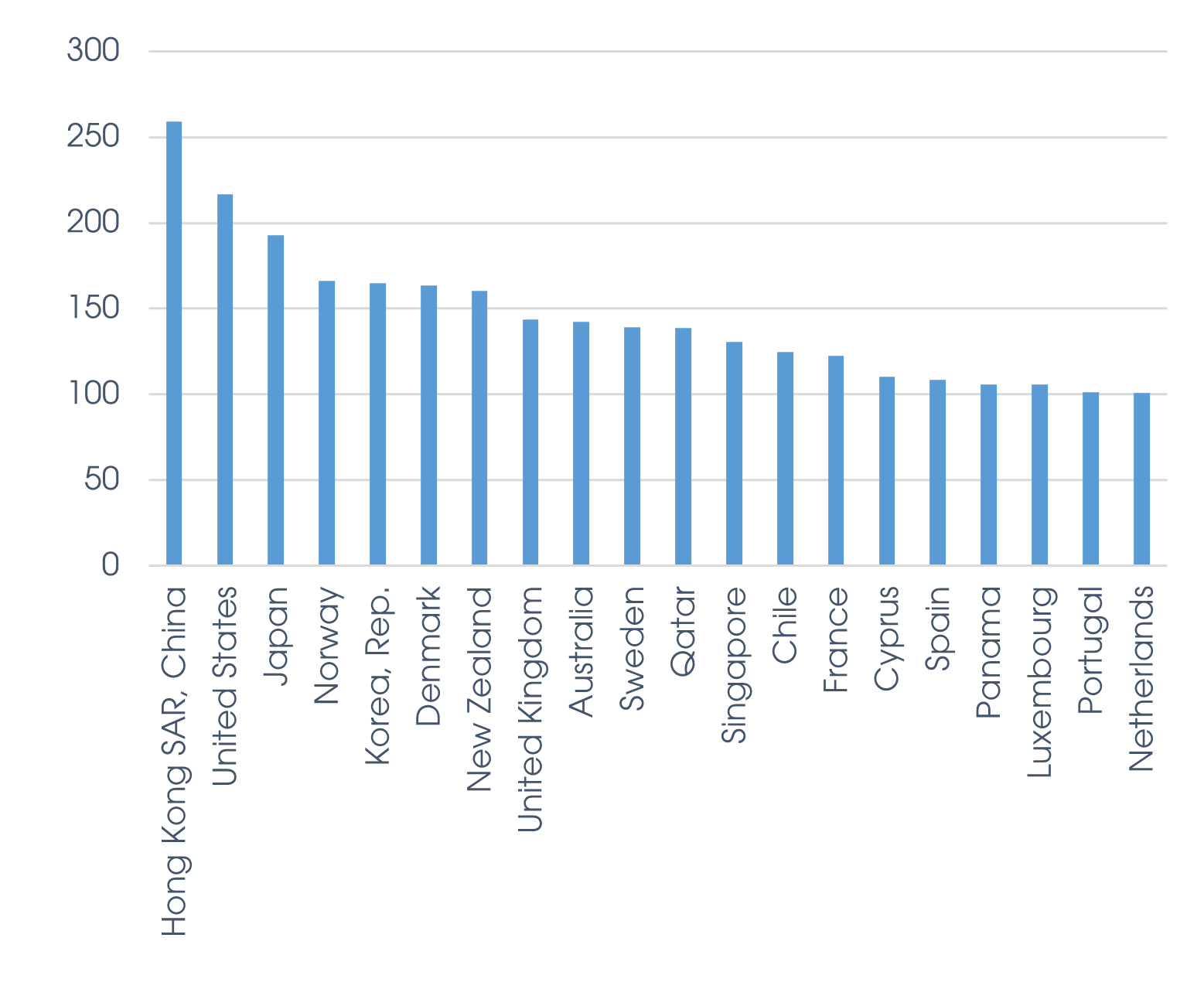
Note: Domestic credit to private sector refers to financial resources provided to the private sector, such as through loans, purchases of nonequity securities, and trade credits and other accounts receivable, that establish a claim for repayment. For some countries these claims include credit to public enterprises.
Source: World Bank Global Financial Development database.
These conditions have supported US leadership of firms in sectors such as technology, healthcare, and consumer services. US companies tend to reinvest more of their free cash flow than their peers elsewhere and have historically earned higher returns on that investment. While these patterns are not uniform across all sectors or firms, they have persisted through different market cycles.
The strength of the US corporate sector is widely acknowledged, but what is less often examined is the extent to which these strengths are already reflected in equity prices. US equities trade at significantly higher valuation multiples than those of other developed markets, resulting in a valuation gap which is not fully explained by differences in profitability or sector composition. The market appears to assign a structural premium to US equities, based on perceptions of inherently higher quality, but also on the assumption that this translates into the persistence of superior performance.
The assumption that US equities deserve structurally higher valuations often draws on their historical return profile, which we turn to in the following section. Though US outperformance is apparent, long-term data casts doubt on its persistence. An analysis of the performance of global equity markets from 1900 to 2020 finds that the US has delivered strong returns, but not by an extraordinary or consistent margin. Outperformance has tended to come in cycles, often concentrated in specific decades.
Further, much of the US market’s current dominance in global indices reflects the compounding of recent success, not an uninterrupted record of leadership. If valuation premiums are justified by historical performance, they must be grounded in a broader, more secular context – not in the extrapolation of a single, unusually favourable period.
And lastly, recent outperformance has been driven by a narrow group of US firms, mainly in technology and platform-based sectors. Yet current valuations imply that a broader set of companies will sustain similar outcomes. This is not a forecast being debated; it is a set of growth assumptions already embedded into market prices. Whether it proves accurate will depend on the continuation of conditions that have been unusually favourable – and may not persist.
While these institutional and macro advantages are widely cited to justify a structural premium, it’s important to ask whether historical returns often used as supporting evidence truly reflect persistent superiority, or something more cyclical or regime-bound.
What drove US outperformance
US equities have delivered strong returns over the past 15 years. From the 2008 global financial crisis (GFC) through 2024, the S&P 500 Index outperformed developed market peers by a wide margin, both in absolute terms and on a risk-adjusted basis. This performance is often attributed to superior fundamentals – stronger earnings growth, better capital allocation, and operational excellence. But return decomposition tells a slightly different story.
Nearly 80 percent of US outperformance relative to non-US equities came not from fundamental return, but from valuation expansion and USD strength. This has important implications: if valuation re-rating and currency gains were the dominant drivers, then the risk is that future returns may mean-revert, particularly if macro conditions or investor sentiment changes.
This raises fundamental questions about the durability of US market leadership. The US grew from around 15 percent of global equity market-capitalisation in 1900 to over 50 percent at the end of their study in 2021. Much of this growth reflects the compounding of past success, rather than an immutable structural advantage. Historical return data is unavoidably shaped by survivorship bias: countries whose markets underperformed often disappeared, stagnated, or became “uninvestable”, while the US remained both accessible and dominant. As a result, global indices today overweight winners and systematically underrepresent markets that failed. Outperformance is easier to claim when lagging markets drop out of indices. But from a forward-looking standpoint, the bar for continued leadership only gets higher.
Equity outperformance has historically shifted across countries and decades: often this is in response to changes in macro conditions, policy regimes, or investor sentiment. Even dominant markets experience reversal. For investors, the risk is not that the US lacks genuine strengths. It is that performance patterns driven by valuation re-rating, currency strength, and concentrated earnings contributions are treated as structural and permanent, when in fact they are historically episodic.
Understanding the composition of past returns helps clarify what is likely to persist – and what may not. It draws a necessary distinction between realised returns and repeatable drivers, and underscores the need for discipline when evaluating long-run allocation decisions. The US has led, and may continue to do so. But the case for that outcome must rest on current evidence, not on an assumed continuation of an exceptional past.
What’s at risk?
The strength of US equity performance in recent years has coincided with unusually favourable conditions. Corporate margins reached record highs, the USD appreciated against global peers, real interest rates remained low, and capital was cheap and abundant. Several of these conditions now appear more uncertain, or may already be reversing.
One area of concern is corporate profitability. S&P 500 companies’ operating margins remain elevated by historical standards, but forward margin estimates have started to flatten. Some of the drivers behind margin expansion over the past decade – low wage pressure, corporate tax cuts, declining interest expense – are unlikely to be repeated. Cost structures are shifting as supply chains are reshored, investment cycles become more policy-driven, and financing becomes more expensive. The pressure on margins is cyclical in part, but also reflects structural changes in the global cost environment.
Exhibit 6: US corporate profits and corporate profits as a share of national income
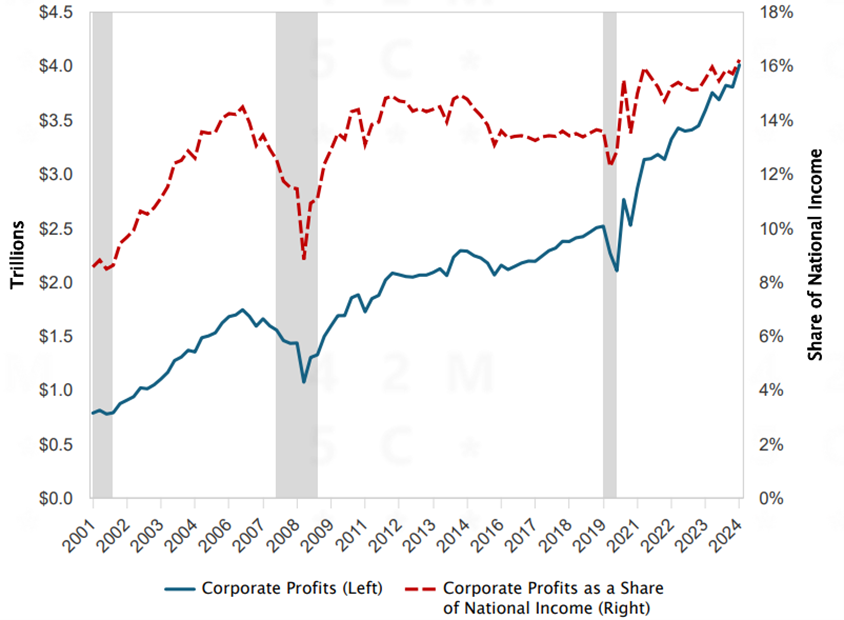
Source: Federal Reserve Bank of St. Louis.
Recent analysis by the Federal Reserve Bank of St. Louis suggests that the post-pandemic surge in US corporate profits has been concentrated in a handful of domestic, non-financial industries – notably retail and wholesale trade, construction, manufacturing, and healthcare – rather than broad-based across sectors or driven by international exposure. This suggests that recent margin strength may not represent a structural reset, and may prove sensitive to cyclical or policy changes.
Valuation risk is also more pronounced. US equities continue to trade at a premium to global peers, but the path forward requires that premium to be sustained or expand further. That leaves less room for error. If earnings growth slows or investor confidence wanes, the index is more exposed to repricing risk. This is particularly relevant in sectors where future earnings are already priced aggressively. A significant portion of the US market’s valuation rests on the durability of long-duration growth assumptions.
USD strength has contributed materially to past outperformance, but may also prove less supportive. Non-USD based investors benefit from exposure to USD via US equities, but not when the USD turns.
The US continues to run large and widening fiscal deficits, and real interest rate differentials have narrowed. While the USD remains central to global portfolios, signs of diversification are growing. The currency contribution to equity returns could reverse, with implications for both performance and risk management.
Political risk extends beyond currency. Adam Posen, writing in Foreign Affairs, argues that the US has shifted from global economic stabiliser to something closer to an “economic predator”. He describes a growing perception that US policy is no longer rules-based, but increasingly transactional and domestically driven. In his view, close allies are responding by self-insuring – building buffers that reduce their reliance on US policy and US assets. This weakens the traditional safe-haven status of US markets and raises the cost of capital over time. If institutional predictability was part of the rationale for a structural valuation premium, that premise may now be under question.
What’s overstated?
In parallel, several of the standard arguments used to justify continued US equity dominance deserve closer examination, not because they lack merit, but because they may already be reflected in market prices.
Capital market depth is an often-cited advantage. US markets are broad, liquid, and institutionally supported. But other markets – including Europe and Asia – have made significant strides in transparency, governance, and accessibility. The premium assigned to US capital markets reflects a legacy of trust, not a monopoly on functionality.
Innovation, measured through R&D spending and intellectual property output, continues to favour the US, but its correlation with equity returns is more modest than often assumed. Recent research highlights that it is not the volume of innovation alone that matters, but its intensity, quality, and the risks investors bear in holding such firms. Higher R&D intensity corresponds with greater subsequent returns, but this seems to reflect a risk premium – investors demand extra return for bearing the uncertainty and volatility associated with R&D-led growth – not mispricing. Overall, innovation remains a structural advantage, but its translation into equity outperformance depends on how effectively firms deploy it and whether investors are compensated for associated risks.
Finally, corporate governance and institutional quality – once clear differentiators – are less obviously advantageous. US equities continue to benefit from shareholder alignment, but regulatory volatility and political interference have become more visible risks. On broader institutional metrics such as rule of law, government effectiveness, and regulatory quality, the US ranks (far) behind several advanced economies as measured by the World Bank (see Exhibit 4).
Implications for portfolios
All told, these do not invalidate the case for continued US equity outperformance, but they weaken the case for assuming its permanence. Market-cap weighting, by construction, extrapolates from the recent past. Strategic allocation requires a different mindset: one that evaluates whether the conditions that enabled past outperformance are likely to persist, and whether current prices already embed optimistic assumptions about those conditions.
A regionally structured equity allocation – such as the one embedded in Bank of Singapore’s Strategic Asset Allocation – offers a more forward-looking approach. It diversifies exposure across economic models, policy regimes, valuation anchors, and currencies. It also avoids overreliance on a narrow set of drivers like valuation expansion or dollar strength, which historical decompositions suggest are episodic, not structural.
Robust optimisation further strengthens this approach by constructing allocations that are resilient across multiple scenarios – not just those that favour US dominance. In an environment of shifting macro regimes and fading tailwinds, we think such an allocation framework is better aligned with long-term investor goals.
Disclaimers and Disclosures
This material is prepared by Bank of Singapore Limited (Co Reg. No.: 197700866R) (the “Bank”) and is distributed in Singapore by the Bank.
This material does not provide individually tailored investment advice. This material has been prepared for and is intended for general circulation. The contents of this material does not take into account the specific investment objectives, investment experience, financial situation, or particular needs of any particular person. You should independently evaluate the contents of this material, and consider the suitability of any product discussed in this material, taking into account your own specific investment objectives, investment experience, financial situation and particular needs. If in doubt about the contents of this material or the suitability of any product discussed in this material, you should obtain independent financial advice from your own financial or other professional advisers, taking into account your specific investment objectives, investment experience, financial situation and particular needs, before making a commitment to purchase any product.
The Bank shall not be responsible or liable for any loss (whether direct, indirect or consequential) that may arise from, or in connection with, any use of or reliance on any information contained in or derived from this material, or any omission from this material, other than where such loss is caused solely by the Bank’s wilful default or gross negligence.
This material is not and should not be construed, by itself, as an offer or a solicitation to deal in any product or to enter into any legal relations. You should contact your own licensed representative directly if you are interested in buying or selling any product discussed in this material.
This material is not intended for distribution, publication or use by any person in any jurisdiction outside Singapore, Hong Kong or such other jurisdiction as the Bank may determine in its absolute discretion, where such distribution, publication or use would be contrary to applicable law or would subject the Bank or its related corporations, connected persons, associated persons or affiliates (collectively “Affiliates”) to any licensing, registration or other requirements in such jurisdiction.
The Bank and its Affiliates may have issued other reports, analyses, or other documents expressing views different from the contents of this material, and may provide other advice or make investment decisions that are contrary to the views expressed in this material, and all views expressed in all reports, analyses and documents are subject to change without notice. The Bank and its Affiliates reserve the right to act upon or use the contents of this material at any time, including before its publication.
The author of this material may have discussed the information or views contained in this material with others within or outside the Bank, and the author or such other Bank employees may have already acted on the basis of such information or views (including communicating such information or views to other customers of the Bank).
The Bank, its employees (including those with whom the author may have consulted in the preparation of this material))and discretionary accounts managed by the Bank may have long or short positions (including positions that may be different from or opposing to the views in this material or may be otherwise interested in any of the product(s) (including derivatives thereof) discussed in material, may have acquired such positions at prices and market conditions that are no longer available, may from time to time deal in such product(s) and may have interests different from or adverse to your interests.
Analyst Declaration
The analyst(s) who prepared this material certifies that the opinions contained herein accurately and exclusively reflect his or her views about the securities of the company(ies) and that he or she has taken reasonable care to maintain independence and objectivity in respect of the opinions herein.
The analyst(s) who prepared this material and his/her associates do not have financial interests in the company(ies). Financial interests refer to investments in securities, warrants and/or other derivatives. The analyst(s) receives compensation based on the overall revenues of Bank of Singapore Limited, and no part of his or her compensation was, is, or will be directly or indirectly related to the inclusion of specific recommendations or views in this material. The reporting line of the analyst(s) is separate from and independent of the business solicitation or marketing departments of Bank of Singapore Limited.
The analyst(s) and his/her associates confirm that they do not serve as directors or officers of the company(ies) and the company(ies)or other third parties have not provided or agreed to provide any compensation or other benefits to the analyst(s) in connection with this material.
An “associate” is defined as (i) the spouse, parent or step-parent, or any minor child (natural or adopted) or minor step-child, or any sibling or step-sibling of the analyst; (ii) the trustee of a trust of which the analyst, his spouse, parent or step-parent, minor child (natural or adopted) or minor step-child, or sibling or step-sibling is a beneficiary or discretionary object; or (iii) another person accustomed or obliged to act in accordance with the directions or instructions of the analyst.
Conflict of Interest Declaration
The Bank is a licensed bank regulated by the Monetary Authority of Singapore in Singapore. Bank of Singapore Limited, Hong Kong Branch (incorporated in Singapore with limited liability), is an Authorized Institution as defined in the Banking Ordinance of Hong Kong (Cap 155), regulated by the Hong Kong Monetary Authority in Hong Kong and a Registered Institution as defined in the Securities and Futures Ordinance of Hong Kong (Cap.571) regulated by the Securities and Futures Commission in Hong Kong. The Bank, its employees and discretionary accounts managed by its Singapore Office/Hong Kong Office may have long or short positions or may be otherwise interested in any of the investment products (including derivatives thereof) referred to in this document and may from time to time dispose of any such investment products. The Bank forms part of the OCBC Group (being for this purpose Oversea-Chinese Banking Corporation Limited (“OCBC Bank”) and its subsidiaries, related and affiliated companies). OCBC Group, their respective directors and/or employees (collectively “Related Persons”) may have interests in the investment products or the issuers mentioned herein. Such interests include effecting transactions in such investment products, and providing broking, investment banking and other financial services to such issuers. OCBC Group and its Related Persons may also be related to, and receive fees from, providers of such investment products. There may be conflicts of interest between OCBC Bank, the Bank, OCBC Investment Research Private Limited, OCBC Securities Private Limited or other members of the OCBC Group and any of the persons or entities mentioned in this report of which the Bank and its analyst(s) are not aware due to OCBC Bank’s Chinese Wall arrangement.
The Bank adheres to a group policy (as revised and updated from time to time) that provides how entities in the OCBC Group manage or eliminate any actual or potential conflicts of interest which may impact the impartiality of research reports issued by any research analyst in the OCBC Group.
Other Disclosures
Singapore
Where this material relates to structured deposits, this clause applies:
The product is a structured deposit. Structured deposits are not insured by the Singapore Deposit Insurance Corporation. Unlike traditional deposits, structured deposits have an investment element and returns may vary. You may wish to seek independent advice from a financial adviser before making a commitment to purchase this product. In the event that you choose not to seek independent advice from a financial adviser, you should carefully consider whether this product is suitable for you.
Where this material relates to dual currency investments, this clause applies:
The product is a dual currency investment. A dual currency investment product (“DCI”) is a derivative product or structured product with derivatives embedded in it. A DCI involves a currency option which confers on the deposit-taking institution the right to repay the principal sum at maturity in either the base or alternate currency. Part or all of the interest earned on this investment represents the premium on this option.
By purchasing this DCI, you are giving the issuer of this product the right to repay you at a future date in an alternate currency that is different from the currency in which your initial investment was made, regardless of whether you wish to be repaid in this currency at that time. DCIs are subject to foreign exchange fluctuations which may affect the return of your investment. Exchange controls may also be applicable to the currencies your investment is linked to. You may incur a loss on your principal sum in comparison with the base amount initially invested. You may wish to seek advice from a financial adviser before making a commitment to purchase this product. In the event that you choose not to seek advice from a financial adviser, you should carefully consider whether this product is suitable for you.
Hong Kong
This material has not been delivered for registration to the Registrar of Companies in Hong Kong and its contents have not been reviewed by any regulatory authority in Hong Kong. Accordingly: (i) the shares/notes may not be offered or sold in Hong Kong by means of any document other than to persons who are "Professional Investors" within the meaning of the Securities and Futures Ordinance (Cap. 571) of Hong Kong and the Securities and Futures (Professional Investor) Rules made thereunder or in other circumstances which do not result in the document being a "prospectus" within the meaning of the Companies (Winding Up and Miscellaneous Provisions) Ordinance (Cap. 32) of Hong Kong or which do not constitute an offer to the public within the meaning of the Companies (Winding Up and Miscellaneous Provisions) Ordinance; and (ii) no person may issue any invitation, advertisement or other material relating to the shares/notes whether in Hong Kong or elsewhere, which is directed at, or the contents of which are likely to be accessed or read by, the public in Hong Kong (except if permitted to do so under the securities laws of Hong Kong) other than with respect to the shares/notes which are or are intended to be disposed of only to persons outside Hong Kong or only to "Professional Investors" within the meaning of the Securities and Futures Ordinance and the Securities and Futures (Professional Investor) Rules made thereunder.
Where this material involves derivatives, do not invest in it unless you fully understand and are willing to assume the risks associated with it. If you have any doubt, you should seek independent professional financial, tax and/or legal advice as you deem necessary.
Where this material relates to a Complex Product, this clause applies:
Warning Statement and Information about Complex Product
(Applicable to accounts managed by Hong Kong Relationship Manager)
Where this material relates to a Complex Product – funds and ETFs, this clause applies additionally:
Where this material relates to a Complex Product (Options and its variants, Swap and its variants, Accumulator and its variants, Reverse Accumulator and its variants, Forwards), this clause applies additionally:
Where this material relates to a Loss Absorption Product, this clause applies:
Warning Statement and Information about Loss Absorption Products
(Applicable to accounts managed by Hong Kong Relationship Manager)
Before you invest in any Loss Absorption Product (as defined by the Hong Kong Monetary Authority), please read and ensure that you understand the features of a Loss Absorption Product, which may generally have the following features:
Where this material relates to a certificate of deposit, this clause applies:
It is not a protected deposit and is not protected by the Deposit Protection Scheme in Hong Kong.
Where this material relates to a structured deposit, this clause applies:
It is not a protected deposit and is not protected by the Deposit Protection Scheme in Hong Kong.
Where this material relates to a structured product, this clause applies:
This is a structured product which involves derivatives. Do not invest in it unless you fully understand and are willing to assume the risks associated with it. If you are in any doubt about the risks involved in the product, you may clarify with the intermediary or seek independent professional advice.
Dubai International Financial Center
Where this material relates to structured products and bonds, this clause applies:
The Distributor represents and agrees that it has not offered and will not offer the product to any person in the Dubai International Financial Centre unless such offer is an “Exempt Offer” in accordance with the Market Rules of the Dubai Financial Services Authority (the “DFSA”).
The DFSA has no responsibility for reviewing or verifying any documents in connection with Exempt Offers.
The DFSA has not approved the Information Memorandum or taken steps to verify the information set out in it, and has no responsibility for it.
The product to which this document relates may be illiquid and/or subject to restrictions in respect of their resale. Prospective purchasers of the products offered should conduct their own due diligence on the products.
Please make sure that you understand the contents of the relevant offering documents (including but not limited to the Information Memorandum or Offering Circular) and the terms set out in this document. If you do not understand the contents of the relevant offering documents and the terms set out in this document, you should consult an authorised financial adviser as you deem necessary, before you decide whether or not to invest.
Where this material relates to a fund, this clause applies:
This Fund is not subject to any form of regulation or approval by the Dubai Financial Services Authority (“DFSA”). The DFSA has no responsibility for reviewing or verifying any Prospectus or other documents in connection with this Fund. Accordingly, the DFSA has not approved the Prospectus or any other associated documents nor taken any steps to verify the information set out in the Prospectus, and has no responsibility for it. The Units to which this Fund relates may be illiquid and/or subject to restrictions on their resale. Prospective purchasers should conduct their own due diligence on the Units. If you do not understand the contents of this document you should consult an authorized financial adviser. Please note that this offer is intended for only Professional Clients and is not directed at Retail Clients.
These are also available for inspection, during normal business hours, at the following location:
Bank of Singapore
Office 30-34 Level 28
Central Park Tower
DIFC, Dubai
U.A.E
BOS Wealth Management Europe S.A., UK Branch
BOS Wealth Management Europe S.A., UK Branch (BOSWME UK), is authorized and regulated by the Financial Conduct Authority (FCA) and is providing this material for informational purposes only. BOSWME UK does not endorse any specific investments or financial products mentioned in this material. BOSWME UK and its employees accept no liability for any loss or damage arising from the use of this material or reliance on its content.
This material is being distributed to and is directed only at persons in the UK who meet the requirements to be considered “Professional Clients” within the meaning of the Conduct of Business Sourcebook rules on client categorisation, part of the FCA Handbook (the “FCA Rules”) and is not intended for retail investors.
Any person in the UK who receives this material will be deemed to have represented and agreed that it can be considered a Professional Client. Any such recipient will also be deemed to have represented and agreed that it has not received this material on behalf of persons in the UK other than Professional Clients for whom the investor has authority to make decisions on a wholly discretionary basis. BOSWME UK will rely upon the truth and accuracy of the foregoing representations and agreements. Any person who is not a Professional Client should not act or rely on this material or any of their contents.
Investing in financial markets carries the risk of losing capital, and investors should be aware of and carefully consider this risk before making any investment decisions. The value of investments can fluctuate, and there is no guarantee that investors will recoup their initial investment. Past performance is not indicative of future results, and the performance of investments can be affected by various factors, including but not limited to market conditions, economic factors, and changes in regulations or tax laws. Forward-looking statements should not be considered as guarantees or predictions of future events. Investors should be prepared for the possibility of losing all or a portion of their invested capital. It is recommended that investors seek professional advice and conduct thorough research before making any investment decisions.
Cross Border Disclaimer and Disclosures
Refer to https://www.bankofsingapore.com/Disclaimers_and_Disclosures.html for cross-border marketing disclaimers and disclosures.
ESG Disclaimer
This document contains information on ESG factors or the Banks’ process for taking into consideration, and evaluation or assessment of ESG factors.
There are currently no universally accepted environmental, social and governance (“ESG”) standards, and no consensus as to whether activities and practices or products or services are “environmentally friendly”, “sustainable”, “responsible”, “climate friendly”, etc. Evaluation of ESG outcomes or metrics may require forward-looking scenario analysis, estimates, interpretations and assumptions and may be uncertain and speculative. There may not be scientific consensus. Scientific evidence and data may not be conclusive or there may be limitations, and new evidence and data may be emerging. ESG standards may depend on subjective or value judgments. ESG standards, as well as laws, rules and regulations may differ from jurisdiction to jurisdiction. Taxonomies have been developed in different jurisdictions to classify activities as “environmentally sustainable”, “green” or the equivalent, and different taxonomies may classify the same activity differently. Achieving one ESG goal may be at the expense of, or require a compromise on, other ESG goals. The Bank’s ESG standards and evaluation or assessment of ESG factors may therefore not meet your expectations or objectives and may not be consistent with certain ESG laws, rules, regulations and standards. There is no guarantee that there will not be negative ESG outcomes, and we do not give any assurance that your investments will have a positive ESG impact. You should ensure that you understand the Bank’s ESG standards and process for evaluation or assessment of ESG factors, and assess whether the Bank’s ESG standards and process for evaluation or assessment of ESG factors meets your expectations or is appropriate for you, before making any investment commitment. You are solely responsible for your own investment decisions.
The Bank relies on third party ESG ratings. While the Bank has selected its third party ESG rating providers in good faith and with reasonable care, the Bank has not independently verified the ESG ratings of third party providers. The Bank gives no representation or warranty, express or implied, as to the quality, accuracy, completeness, rigour, timeliness or verifiability of such third party ESG ratings, and shall not be responsible or liable for such third party ESG ratings. ESG ratings may be based on data that is incomplete, due to limitations or otherwise, or based on commitments and targets which may not be achieved. You should review and understand the disclosures made by such third party ESG ratings providers on their methodologies, data sources and other relevant information, and obtain advice from professional advisers as necessary.
Taking into consideration ESG factors may be at the expense of higher financial returns, especially in the short term. Although ESG risks may result in financial losses, such losses may, and if at all, only materialise in the long term. ESG factors and screening may also result in certain investments that deliver high financial returns being excluded, or limit the diversity of investments, which could in turn affect the volatility of portfolios.
ESG Ratings and data provided by:
MSCI ESG Research LLC
Certain information ©2025 MSCI ESG Research LLC. Reproduced by permission.
Although Bank of Singapore Limited’s information providers, including without limitation, MSCI ESG Research LLC and its affiliates (the “ESG Parties”), obtain information (the “Information”) from sources they consider reliable, none of the ESG Parties warrants or guarantees the originality, accuracy and/or completeness, of any data herein and expressly disclaim all express or implied warranties, including those of merchantability and fitness for a particular purpose. The Information may only be used for your internal use, may not be reproduced or redisseminated in any form and may not be used as a basis for, or a component of, any financial instruments or products or indices. Further, none of the Information can in and of itself be used to determine which securities to buy or sell or when to buy or sell them. None of the ESG Parties shall have any liability for any errors or omissions in connection with any data herein, or any liability for any direct, indirect, special, punitive, consequential or any other damages (including lost profits) even if notified of the possibility of such damages.
For details on MSCI ESG rating included in the research report, please refer to the MSCI website : ESG Ratings - MSCI
This report is being made available to you through an arrangement between Bank of Singapore Limited and ESG Parties. Pursuant to Regulation 32C of the Singapore Financial Advisers Regulations (Cap. 110, REG 2), if you are not an accredited investor, expert investor or institutional investor, Bank of Singapore Limited accepts legal responsibility for the contents of this report.
Please contact Bank of Singapore Limited with respect to any matter arising from, or in connection with, this report or the analysis within. This document is prepared for the non-institutional, high net worth individual clients of Bank of Singapore Limited and their family offices, private investment companies, trusts, asset managers and financial advisors.
© 2025 Bank of Singapore Limited. All rights reserved.
